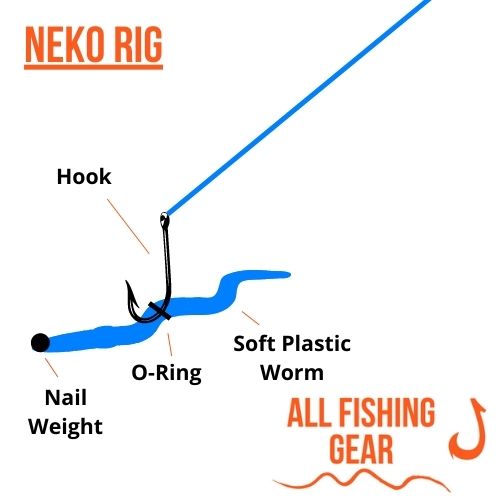In recent decades, the Neko rig has become one of the most popular lure presentation styles among professional bass anglers. It’s one that’s very similar to the Wacky rig in a lot of ways, but what makes the Neko rig special is how the angler fishes it.
In this article, I’ll discuss some of the basic information you need to know regarding the Neko rig and explain some of the prominent tips and techniques the pros use to catch a limit using it. The Neko Rig is one of my favorite worm rigs for bass.
Table of Contents
What is a Neko Rig?
The Neko rig was first made popular in Japan by legendary lure designer and angler, Haruhiko Murakami. He wanted to use soft plastic lures in a way that looked more like a bait fish that’s quickly working it’s way along the bottom as they so often do. Murakami added a small, but heavy tungsten weight to the worm and used an O-ring hook style to maximize the amount of swimming action as it is twitched across the bottom.
Murakami named his creation the “Neko-sogi,” which means “lure that catches everything like a vacuum cleaner” in Japanese. The rig exploded in popularity and it didn’t take long for it to catch on with professional anglers in America who shortened the name to “Neko rig.”
The Neko rig consists of a soft plastic worm, which is usually a senko or finesse worm, but some anglers have opted for creature baits like crawfish. Some brands produce soft plastic lures that are specifically designed to be used with the Neko rig.
You can use a drop shot or circle hook along with your choice of O-ring to hold the hook in place. Set the O-ring in the middle of the worm to get the right amount of action. If you don’t have any O-rings handy, you can run your hook through the soft plastic worm in a pinch.
The Neko rig performs best with a nail weight, which is a thin weight that’s made of tungsten and resembles a short nail without a head. There are a variety of different nail weights or other types of weights made by companies, so you can take your pick based on the size or style of soft plastic you’re using.

When and Where to Use the Neko Rig
The Neko rig is meant to target fish that are in deeper water or near the bottom. However, anglers have found that the Neko rig actually works in virtually any situation you’re willing to use it in as long as you can avoid getting the hook snagged.
Most anglers fish the Neko rig along points or near ledges and drop-offs, but you can also throw it near cover like brush piles, rocks, and other structure like docks. It’s become a common rig for anglers who want to fish for suspended bass as they simply use a steady retrieve while keeping the Neko rig at the same level in the water column and gently twitch it as they work the lure back to them.
This technique can be used to fish for bass that are hidden in grass along the bottom if you work the Neko above them without letting it sink all the way down. I prefer to fish the Neko rig along the bottom by consistently bouncing it along and sometimes letting it sit still on the bottom for a few seconds. Bass tend to bite immediately after you pause the bait like this, usually as soon as you twitch it again.
Conclusion
A Neko rig works best when fished with a long spinning rod and reel setup, and most anglers use fluorocarbon line that’s either 8 pounds or up to 12 if you’re going to fish around heavy cover. Once you have finally mastered the Neko rig and the right way to produce the swimming action that makes it so effective, you’ll see why the inventor of the Neko compared it to a vacuum that catches anything that comes across it.
